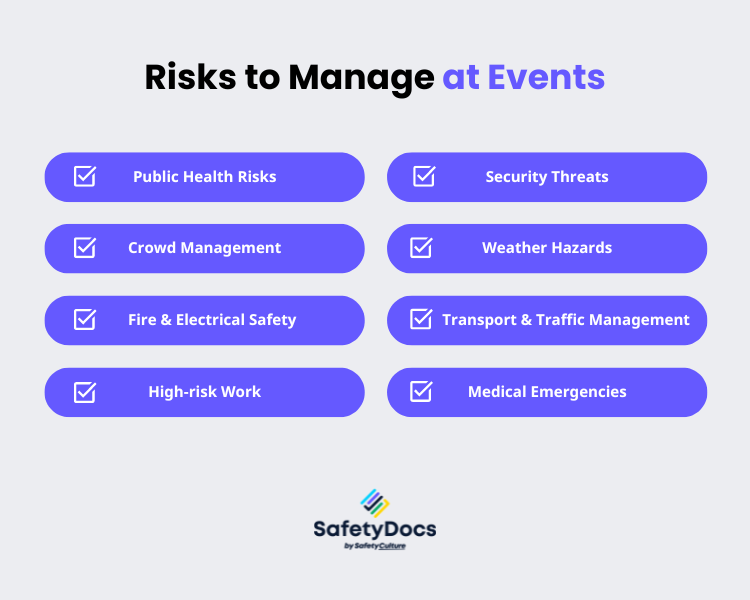Events can be on a small scale, like local community events, fundraisers, or grand productions, like music festivals. One thing they all have in common is the need for event safety management. The success of an event often hinges on its safety.
Risks at events can range from minor injuries to catastrophic incidents, and with the growing emphasis on Occupational Health and Safety (OHS) today, the event manager and planner must be proactive in managing safety at their events. In this blog post, we have compiled what the OHS checklist must have for events management based on industry best practices and solutions.
Risks at Events
At the 2018 Defqon.1 festival in Australia, two young attendees died from suspected drug overdoses due to inadequate medical response, with only two doctors for 30,000 people and significant delays in care. This tragedy highlights the importance of a comprehensive OHS plan.
Event planners are responsible for the safety of everyone attending their events, including staff, volunteers, and vendors. Proper safety measures help detect and prevent potential threats, handle emergencies effectively, and ensure a secure environment.
The following risks must be considered and managed:
- Public Health Risks: The spread of diseases or food borne illnesses due to inadequate sanitation, hygiene, and food safety practices.
- Crowd Management: Depending on the event's scale, crowd control measures must be implemented to prevent overcrowding and stampedes.
- Fire and Electrical Safety: With pyrotechnics, electrical equipment, and large structures at events, there is an increased risk of fires and electrocution.
- High-risk Work: Events may involve high-risk work activities like rigging, scaffolding, or operating heavy machinery.
- Security Threats: You can never be too prepared for security threats at events. A proactive approach to security management is crucial.
- Weather Hazards: Unpredictable weather can disrupt events, particularly outdoor ones. Planners should have contingency plans, such as alternative venues or weather monitoring systems.
- Transport and Traffic Management: High traffic volumes can create congestion and delays for large events.
- Medical Emergencies: Events can lead to various medical issues, from minor injuries to severe health crises.

What is an Event Management Plan
An Event Management Plan (EMP) is a comprehensive document outlining all the details and logistics necessary for organising and executing a successful event. It includes information on the event's objectives, timelines, budget, venue, staffing, safety measures, permits, risk management, marketing, and contingency plans. The EMP is a roadmap to guarantee effective coordination of all event aspects and proactive anticipation of issues. It can also be called an event safety or OHS management plan.
Key Components of an Event Management Plan
For the safety and success of events, it's crucial to implement a well-structured and detailed OHS plan. Here are the critical components that should be included in the events management plan:
1. Contractor and Vendor Management
Event planners often work with contractors and vendors to bring an event to life. This is the first area to look at when managing OHS risks. To ensure that the contractors and vendors comply with safety standards, event planners must:
- Assess the safety records and practices of potential vendors and contractors
- Include safety clauses in contracts to ensure compliance with regulations
- Provide OHS training to contractors and vendors
- Have a system for regular safety inspections of equipment and materials contractors use
2. Event Overview and Risk Assessment
The EMP should outline the event's purpose, objectives, expected attendance, and layout. Following this, a risk assessment will be conducted to identify potential hazards.
Conduct an Event Risk Assessment
An event risk assessment is the cornerstone of an effective OHS plan. This process involves identifying potential hazards that could impact the event and its participants. Key areas to consider include:
- Venue Hazards: Assessing structural integrity, fire safety, and accessibility.
- Activity-Related Risks: Identifying risks associated with specific activities planned for the event, such as stage setups or sports activities.
- Environmental Factors: Considering weather conditions, natural disasters, and other environmental impacts.
Develop Mitigation Strategies
Once hazards are identified, the next step is developing strategies to mitigate these risks. This includes:
- Implementing engineering controls (e.g., barriers, guardrails).
- Establishing administrative controls (e.g., safety protocols, signage).
- Providing personal protective equipment (PPE) where necessary.
3. Emergency Management and Response Plan
Events can present various emergencies, including medical emergencies, fire incidents, or natural disasters. Therefore, the OHS plan must include a comprehensive emergency management and response plan. The plan should clearly:
- Outline procedures for responding to different emergency scenarios.
- Identify key personnel responsible for implementing the emergency response plan.
- Establish communication protocols and evacuation procedures.
- Ensure that all participants are aware of these plans through training and drills.
Key components of the response plan include:
- Communication Protocols: Establish clear communication channels for notifying staff, emergency services, and attendees in an emergency.
- Evacuation Procedures: Develop detailed evacuation plans, including designated exits, assembly points, and routes.
- First Aid Provisions: Ensuring adequate first aid supplies and trained personnel are on-site to provide medical assistance.
4. Facilities Management
Facilities management for event safety involves overseeing and coordinating various physical aspects of the event venue. This includes managing the infrastructure, services, and logistical elements necessary to support the event, such as:
- Venue Inspection (event site, temporary structures, stages, and other installations)
- Crowd Control and Management
- First Aid and Medical Facilities
- Sanitation
- Food Safety
- Waste Management
- Setup and teardown of event infrastructures
5. Traffic and Transportation Management
Gatherings, whether large or small, can pose significant transportation and traffic challenges. An OHS plan should include a comprehensive traffic and transport management strategy to ensure the safe and efficient movement of attendees, staff, and participants in and out of the event venue.
Key considerations for traffic and transportation management include:
- Assessing road conditions leading to the event venue
- Implementing traffic control measures (e.g., signage, temporary barriers).
- Coordinating with local authorities for road closures or alternative routes.
6. Training and Communication Plan
The success of an OHS plan relies on effective training and communication. All personnel involved in the event should receive proper training on their roles and responsibilities and what safety protocols to follow.
Safety Training
Training is crucial for ensuring that staff and volunteers know safety processes. This includes:
- Orientation Sessions: Providing initial safety training for all staff and volunteers.
- Regular Drills: Conducting emergency drills to ensure preparedness.
Clear Communication of Safety Rules
Effective communication ensures that all attendees understand the safety rules. This can be achieved through:
- Signage: Clear and visible signs will be placed throughout the venue.
- Announcements: Make regular safety announcements during the event.
- Information Materials: Distributing brochures or leaflets with safety information.
7. Incident Reporting and Management
If an incident or injuries occur during the event, it is crucial to have an established process for reporting and investigating them. This enables the detection of potential bottlenecks in the OHS plan and the immediate implementation of corrective measures.
Reporting Incidents
All staff, participants, vendors, or contractors must know how to report an incident immediately. This could involve notifying designated personnel or using an incident reporting form.
Investigation and Analysis
Investigating could involve reviewing event footage, conducting witness interviews, or consulting workplace safety experts.
Follow-up Actions
Based on the incident investigation findings, follow-up actions should be taken promptly to prevent similar incidents from occurring in the future. This may include updating safety procedures, providing additional training, or making necessary changes.
OHS Checklist for Events
Here is a comprehensive event safety checklist essential for small to medium-sized community events. Below is a detailed checklist to help you cover crucial safety aspects:
Planning and Preparation
1. Risk Assessment
- Identify potential hazards
- Evaluate the risk level of each hazard
- Develop mitigation strategies
2. Permits and Approvals
- Obtain necessary permits from local authorities
- Ensure compliance with local regulations and guidelines
3. Emergency Plan
- Develop an emergency response plan
- Designate emergency exits and assembly points
- Communicate the plan to all staff and volunteers
4. First Aid
- Arrange for first aid stations and equipment
- Ensure the presence of trained first aid personnel
5. Site Inspection
- Conduct a thorough site inspection
- Identify and address any safety hazards
- Provide toilet and handwashing facilities
Site Setup
1. Crowd Management
- Designate entry and exit points
- Implement crowd control measures (e.g., barriers, signage)
2. Security
- Hire security personnel if needed
- Coordinate with local police for additional support
3. Fire Safety
- Install fire extinguishers and alarms.le regular cleaning and waste removal.
- Ensure staff are trained in fire safety procedures
4. Sanitation and Hygiene
- Provide adequate restrooms and handwashing stations
- Schedule proper cleaning and maintenance
5. Accessibility
- Give provision to make the event accessible to people with disabilities
- Provide ramps, grab bars, accessible restrooms, and other accessible accommodations
6. Traffic Flow and Parking
- Develop a transportation management plan
- Arrange for adequate parking facilities
7. Safety Signage
- Install clear and visible safety signs throughout the venue
- Include directions to emergency exits, first aid stations, and other essential facilities
During the Event
1. Staff and Volunteer Briefing
- Conduct a safety briefing before the event starts
- Ensure everyone knows their roles and responsibilities
2. Communication
- Establish clear communication channels (e.g., radios, phones)
- Ensure all staff can communicate effectively during emergencies
3. Monitoring
- Continuously monitor the event for potential safety issues
- Have designated staff or volunteers patrol the area
4. Weather Preparedness
- Monitor weather forecasts
- Have contingency plans for adverse weather conditions
5. Food and Beverage Safety
- Ensure food vendors comply with health and safety regulations
- Provide clean drinking water for attendees
6. Electrical Safety
- Verify that all electrical installations are safe and meet regulations
- Use proper cable management to prevent tripping hazards
Post-Event
1. Debriefing
- Conduct a post-event debrief with staff and volunteers
- Discuss any incidents or safety concerns that arose
2. Incident Reporting
- Document any incidents or near-misses.
- Review and analyse incident reports to improve future events
3. Site Clean-Up
- Ensure proper disposal of waste and recyclables
- Leave the venue in a clean and safe condition
4. Documentation
- Maintain records of all safety-related documents, including permits, risk assessments, and incident reports
- Keep a copy of the OHS plan for future reference
Save Time with SafetyDocs
If you manage an event and need assistance creating an OHS plan, consider using the Events Management Plan from SafetyDocs by SafetyCulture. Our templates are easy to use and cover all essential safety aspects, from hazard identification to emergency response. You also have the option to customise the template according to your event's specific needs. With SafetyDocs, nothing is left to chance, and you can always ensure a safe and successful event.
Contact us to learn more about our safety templates and how we can help you streamline your OHS planning process.
Our team of experts is dedicated to providing accurate and informative content. Craig Cruickshank, our senior HSEQ advisor at SafetyDocs by SafetyCulture has reviewed this blog post to ensure the highest level of quality.
Learn more about Craig's work on LinkedIn for more industry insights.
Available for instant download and supplied in fully editable MS Word format for use in your business.
Please note that the above information is provided as a comment only and should not be relied on as professional, legal or financial advice.
Share This Article
